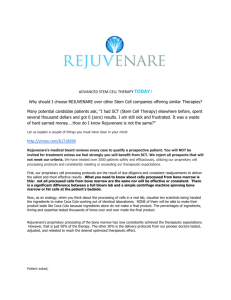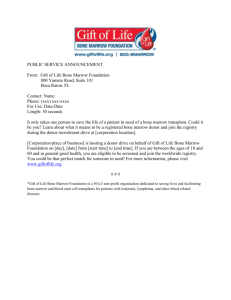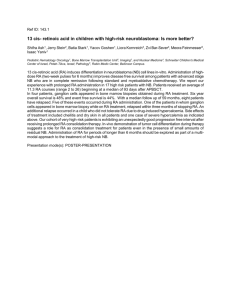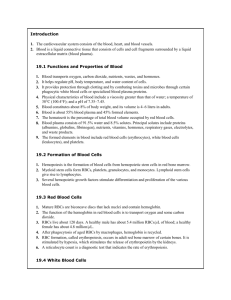Basophils (Nick, Hannah)
advertisement
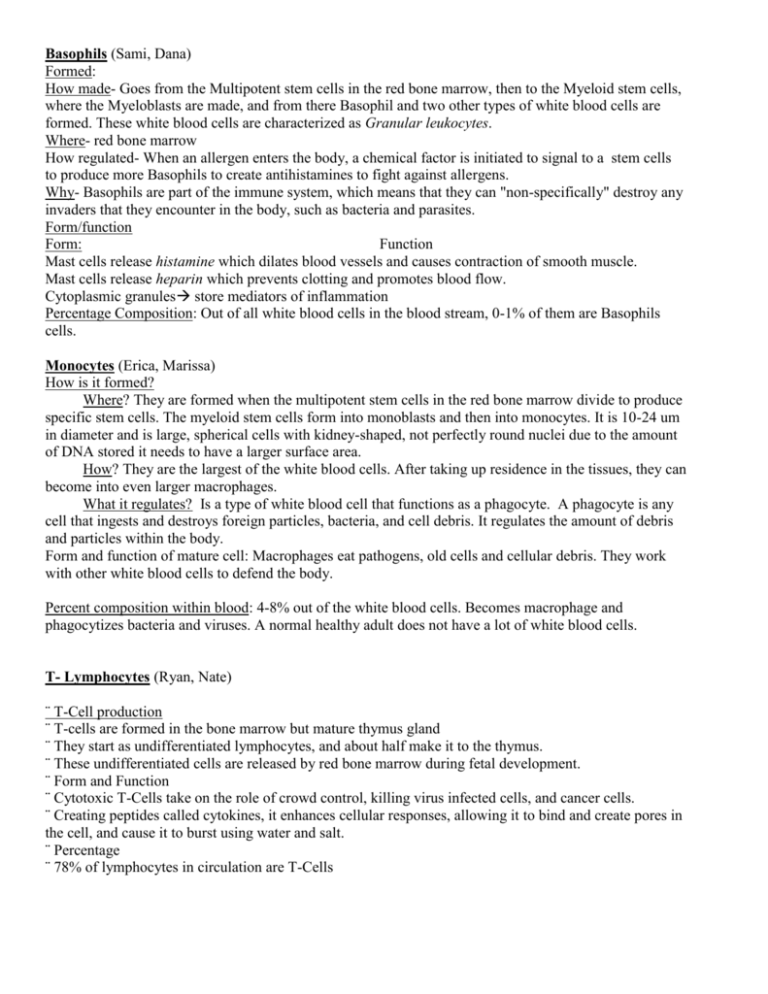
Basophils (Sami, Dana) Formed: How made- Goes from the Multipotent stem cells in the red bone marrow, then to the Myeloid stem cells, where the Myeloblasts are made, and from there Basophil and two other types of white blood cells are formed. These white blood cells are characterized as Granular leukocytes. Where- red bone marrow How regulated- When an allergen enters the body, a chemical factor is initiated to signal to a stem cells to produce more Basophils to create antihistamines to fight against allergens. Why- Basophils are part of the immune system, which means that they can "non-specifically" destroy any invaders that they encounter in the body, such as bacteria and parasites. Form/function Form: Function Mast cells release histamine which dilates blood vessels and causes contraction of smooth muscle. Mast cells release heparin which prevents clotting and promotes blood flow. Cytoplasmic granules store mediators of inflammation Percentage Composition: Out of all white blood cells in the blood stream, 0-1% of them are Basophils cells. Monocytes (Erica, Marissa) How is it formed? Where? They are formed when the multipotent stem cells in the red bone marrow divide to produce specific stem cells. The myeloid stem cells form into monoblasts and then into monocytes. It is 10-24 um in diameter and is large, spherical cells with kidney-shaped, not perfectly round nuclei due to the amount of DNA stored it needs to have a larger surface area. How? They are the largest of the white blood cells. After taking up residence in the tissues, they can become into even larger macrophages. What it regulates? Is a type of white blood cell that functions as a phagocyte. A phagocyte is any cell that ingests and destroys foreign particles, bacteria, and cell debris. It regulates the amount of debris and particles within the body. Form and function of mature cell: Macrophages eat pathogens, old cells and cellular debris. They work with other white blood cells to defend the body. Percent composition within blood: 4-8% out of the white blood cells. Becomes macrophage and phagocytizes bacteria and viruses. A normal healthy adult does not have a lot of white blood cells. T- Lymphocytes (Ryan, Nate) ¨ T-Cell production ¨ T-cells are formed in the bone marrow but mature thymus gland ¨ They start as undifferentiated lymphocytes, and about half make it to the thymus. ¨ These undifferentiated cells are released by red bone marrow during fetal development. ¨ Form and Function ¨ Cytotoxic T-Cells take on the role of crowd control, killing virus infected cells, and cancer cells. ¨ Creating peptides called cytokines, it enhances cellular responses, allowing it to bind and create pores in the cell, and cause it to burst using water and salt. ¨ Percentage ¨ 78% of lymphocytes in circulation are T-Cells Eosinophils (Bri, Tink) How is it formed? 1) Form in bone marrow 2) Eight day maturation process 3) Move into the blood cells 4) Travel through blood cells for 8-12 hours 5) Arrive at destination tissue 6) Remain there for 1-2 weeks Form and function · Organ formation (not yet proven, but possible)· Movement to inflamed areas· Trapping substances· Kills cells· Antiparasitic and bactericidal activity· Participate in immediate allergic reactions· Modulate inflammatory responsesComposition in Blood Typically quite low, but increase in number in diseases and infections such as with parasitic worms in order to maintain homeostasis in controlling the infection. B lympyocytes (Heather, Nichole) Used for cell immunity against diseases Create plasma cells which produce antibodies Antibodies attach to the diseased cells to tag it to be killed by T-cells How are they created Created in the bone marrow Created with process called Mitosis, or cell division the body creates more B cells when the body is diseased. Once a disease is identified b cells create more B cells by B cell cloning. o This allows for immunity aganist the disease in the future: chicken pox. . Form follows fuction . Each B cell has different antigen receptors. (Proteins) o This allows them to recognize different antigens . Have a large nucleus holding DNA and ribosomes which allows for the protein synthesis and creation of antibodies. . Percent composition within the blood stream . The number of B cells in the blood varies because of the antigens which may be in the body o Ranges from 4950 per 1 mm3 of blood. o 20-45% Thrombocytes (Nick, Hannah) Have specialized proteins coating their surfaces which help them stick together and form a thick, shield-like structure to prevent blood loss in injury. Thrombocytes float in the plasma along with the red blood cells. Thrombocytes make up one of four parts of blood, the platelets. What it regulates: Thrombocytes, or platelets, aid in clotting blood. They work by clumping together to block off blood flow and prevent blood leakage due to injury. Thrombocytes are found in the blood. They are produced at a rate of 200 million per day. Formation: Liver produces a hormone called thrombopoietin that targets the bone marrow. Bone marrow is stimulated to produce more Megakaryocytes Megakaryocytes are broken into thrombocytes. Thrombocytes last only about 7-10 days. Insufficient thrombocytes in the blood results in hemophilia. Nuetrophils (Kalee, Allegra) Cell Formation: Where - derived from stem cells in the red bone marrow How - mitosis; it goes through several developmental stages (see next slide) What regulates it- hormones and chemical signals Form & Function Multilobed nucleus that is connected by nuclear threads Multinucleated (many nuclei) Usually the first responders to respond to an injury site Contains many lysosomes in order to actively eat and digest bacteria Composition 50 to 70% of circulating blood are neutrophils Red Blood Cells (Caroline T.) What are RBC's? Red blood cells, more accurately called erythrocytes, function to transport oxygen around the body. RBCs are far and away the most abundant cells in the blood, making up 40-45% of normal blood. How are They Formed? RBCs are formed in a process called erythropoiesis. Starting as many cells do, RBCs begin as multipotent stem cells. After undergoing many phase changes, the stem cell becomes a erythroblast. This is the stage right before a mature RBC. Where as RBCs have exocytosized their nucleus, erythroblasts still contain their nucleus. Regulation of RBC Levels Erythropoiesis is regulated by a hormone called erythropoietin (EPO). Produced by the kidneys, erythropoietin is secreted when a low oxygen level is detected in the blood. How do RBCs Function RBCs contain molecules of hemoglobin which carries out the cells function of transporting oxygen and CO2 as waste. About 70% of your bodies iron is found in your hemoglobin. This is what gives RBCs their color.
